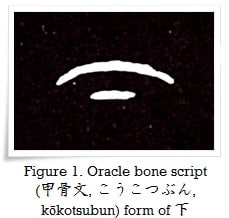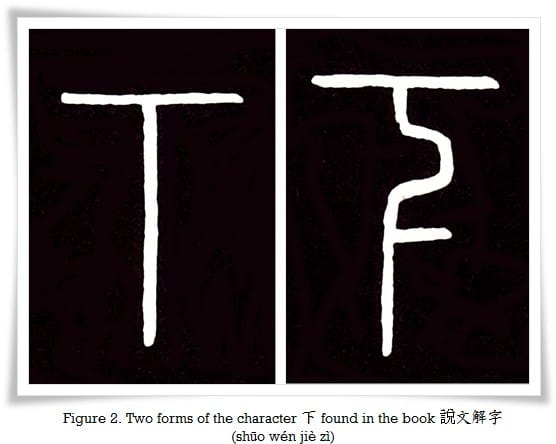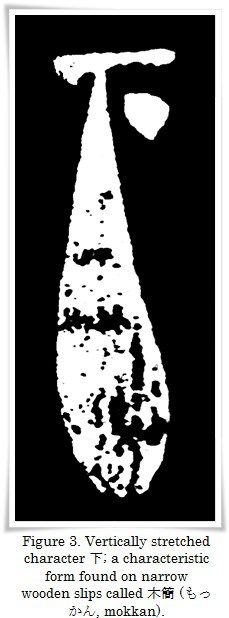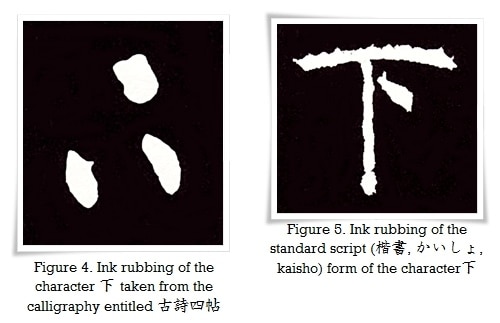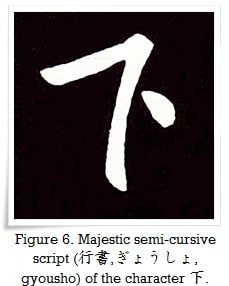1. Meaning:
below, descend, down, to give, inferior, low
2. Readings:
3. Etymology
下 belongs to the 指事文字 (しじもじ, shijimoji, i.e. set of characters expressing simple abstract concepts). The original idea expressed by the oracle bone script (甲骨文, こうこつぶん, kōkotsubun) forms, as well as the 金文 (きんぶん, kinbun, i.e. “text on metal”) forms that preceded later forms of 篆文 (てんぶん, tenbun, i.e. “seal (script) text”), suggest that 下 was a concept of a cover, concealing an object placed below a bent human palm (Figure 1).
According to the 說文解字 (shūo wén jiè zì, i.e. “Explaining Simple (Characters) and Analyzing Compound Characters”) from the 2nd century C.E., compiled by a philologist of the Han dynasty (漢朝, 206 BCE – 220 CE), 許慎 (Xǔ Shèn, ca. 58 C.E. – ca. 147 C.E.), the character 下 originally meant “the lower part”. In later stages its meaning was broadened to the general idea of “below”, or “under”.
Latter 篆文 forms of the character 下 show a vertical line written downwards from the middle of the horizontal line (Figure2, left).
The kanji 上 (うえ, ue, i.e. “above”) is based on a similar concept, (originally) being the exact opposite of 下.
4. Selected historical forms of 下.
Figure 1. Oracle bone script (甲骨文, こうこつぶん, kōkotsubun) form of 下, from ca.1600 B.C.
Figure 2. Two forms of the character 下 found in the book 說文解字 (shūo wén jiè zì), 篆書 (てんしょ, tensho, i.e. “seal script”). This is great example of the variety of forms in Seal script.
Figure 3. Vertically stretched character 下; a characteristic form found on narrow wooden slips called 木簡 (もっかん, mokkan). Pictured character is from the collection of bamboo slips referred to as 武威漢簡 (Chinese: Wǔ wēi hàn jiǎn, i.e. “bamboo slips from Wu Wei (prefecture)”, which is located in 甘粛省 (Chinese: Gānsù province). Ink on bamboo, early Han dynasty (前漢, 206 – 8 B.C.
Figure 4. Ink rubbing of the character 下 taken from the calligraphy entitled 古詩四帖 (Chinese: gǔ shī sì tiē) by 張旭 (Zhāng Xù, unfortunately, the exact dates of his birth and death are unknown) of the Tang dynasty (唐朝, 618 – 907) in Cursive script (草書, そうしょ, sōsho), or more precisely, in a cursive style created by this brilliant calligrapher, known as 狂草 (kuáng cǎo i.e. “mad draft”).
Figure 5. Ink rubbing of the Standard script (楷書, かいしょ, kaisho) form of the character 下, from the calligraphy entitled 昭仁寺碑 (Chinese: zhāo rén sì bēi) 虞世南 (Yú Shìnán, 558 – 638)of the late Sui (隋朝, 581 – 618) and early Tang (唐朝, 618 – 907) dynasties.
Figure 6. Majestic Semi-cursive script (行書, ぎょうしょ, gyousho) of the character 下. Ink rubbing from the calligraphy by the emperor Tài Zhōng (太宗, 626 – 649) of the Tang dynasty (唐朝, 618 – 907).

